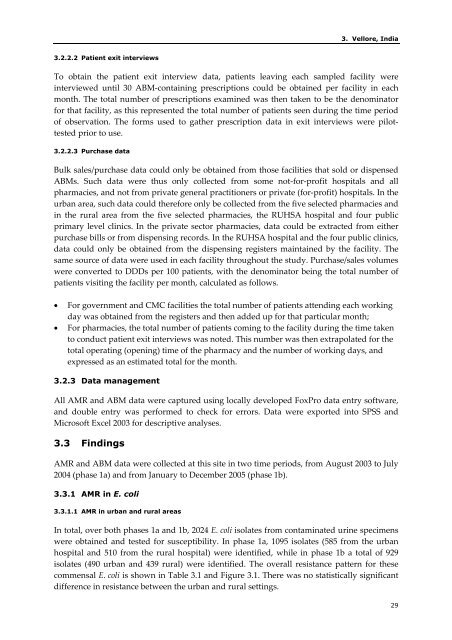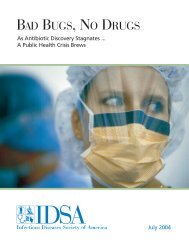Community-Based Surveillance of Antimicrobial Use and ...
Community-Based Surveillance of Antimicrobial Use and ...
Community-Based Surveillance of Antimicrobial Use and ...
- No tags were found...
Create successful ePaper yourself
Turn your PDF publications into a flip-book with our unique Google optimized e-Paper software.
3. Vellore, India3.2.2.2 Patient exit interviewsTo obtain the patient exit interview data, patients leaving each sampled facility wereinterviewed until 30 ABM‐containing prescriptions could be obtained per facility in eachmonth. The total number <strong>of</strong> prescriptions examined was then taken to be the denominatorfor that facility, as this represented the total number <strong>of</strong> patients seen during the time period<strong>of</strong> observation. The forms used to gather prescription data in exit interviews were pilottestedprior to use.3.2.2.3 Purchase dataBulk sales/purchase data could only be obtained from those facilities that sold or dispensedABMs. Such data were thus only collected from some not‐for‐pr<strong>of</strong>it hospitals <strong>and</strong> allpharmacies, <strong>and</strong> not from private general practitioners or private (for‐pr<strong>of</strong>it) hospitals. In theurban area, such data could therefore only be collected from the five selected pharmacies <strong>and</strong>in the rural area from the five selected pharmacies, the RUHSA hospital <strong>and</strong> four publicprimary level clinics. In the private sector pharmacies, data could be extracted from eitherpurchase bills or from dispensing records. In the RUHSA hospital <strong>and</strong> the four public clinics,data could only be obtained from the dispensing registers maintained by the facility. Thesame source <strong>of</strong> data were used in each facility throughout the study. Purchase/sales volumeswere converted to DDDs per 100 patients, with the denominator being the total number <strong>of</strong>patients visiting the facility per month, calculated as follows.• For government <strong>and</strong> CMC facilities the total number <strong>of</strong> patients attending each workingday was obtained from the registers <strong>and</strong> then added up for that particular month;• For pharmacies, the total number <strong>of</strong> patients coming to the facility during the time takento conduct patient exit interviews was noted. This number was then extrapolated for thetotal operating (opening) time <strong>of</strong> the pharmacy <strong>and</strong> the number <strong>of</strong> working days, <strong>and</strong>expressed as an estimated total for the month.3.2.3 Data managementAll AMR <strong>and</strong> ABM data were captured using locally developed FoxPro data entry s<strong>of</strong>tware,<strong>and</strong> double entry was performed to check for errors. Data were exported into SPSS <strong>and</strong>Micros<strong>of</strong>t Excel 2003 for descriptive analyses.3.3 FindingsAMR <strong>and</strong> ABM data were collected at this site in two time periods, from August 2003 to July2004 (phase 1a) <strong>and</strong> from January to December 2005 (phase 1b).3.3.1 AMR in E. coli3.3.1.1 AMR in urban <strong>and</strong> rural areasIn total, over both phases 1a <strong>and</strong> 1b, 2024 E. coli isolates from contaminated urine specimenswere obtained <strong>and</strong> tested for susceptibility. In phase 1a, 1095 isolates (585 from the urbanhospital <strong>and</strong> 510 from the rural hospital) were identified, while in phase 1b a total <strong>of</strong> 929isolates (490 urban <strong>and</strong> 439 rural) were identified. The overall resistance pattern for thesecommensal E. coli is shown in Table 3.1 <strong>and</strong> Figure 3.1. There was no statistically significantdifference in resistance between the urban <strong>and</strong> rural settings.29




